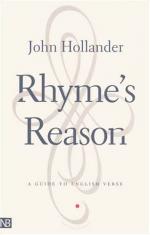|
This section contains 432 words (approx. 2 pages at 400 words per page) |

|
Accentual-Syllabic Verse
Accentual syllabic verse is the dominant verse style in English poetry. It describes a style where each line has a defined number of metrical "feet," or groups of syllables, with each foot usually conforming to the same accentual pattern.
Pure Accentual Verse
Pure accentual verse is a style that sticks to a fixed number of accented syllables in a line with very little variation. Nursery rhymes are examples of pure accentual verse.
Pure Syllabic Verse
Pure syllabic verse is a style where each line has a fixed number of syllables, regardless of their accent. Japanese haiku is an example of pure syllabic verse.
Free Verse
Free verse is a style that does not stick to any particular meter or rhyme scheme. Lines are divided according to meaning, sound, or other purposes of the author.
Quantitative Verse
Quantitative verse is a style originally used in early Greek...
|
This section contains 432 words (approx. 2 pages at 400 words per page) |

|




